Small symbols hold significant meaning in the intricate world of cross stitches, serving as critical elements in deciphering the elaborate language of embroidery charts.
These diminutive symbols, often found in cross-stitch patterns, encapsulate crucial information about stitches, colors, and specialty techniques.
Each small symbol is a visual cue, guiding stitchers through the meticulous process of recreating detailed designs on fabric.
The importance of these symbols lies in their ability to condense complex information, facilitating efficient pattern navigation and ensuring the faithful replication of the intended masterpiece.
Understanding what a small symbol means in a cross stitch is paramount for enthusiasts, unraveling the path to transforming a blank canvas into a vibrant and textured work of art.
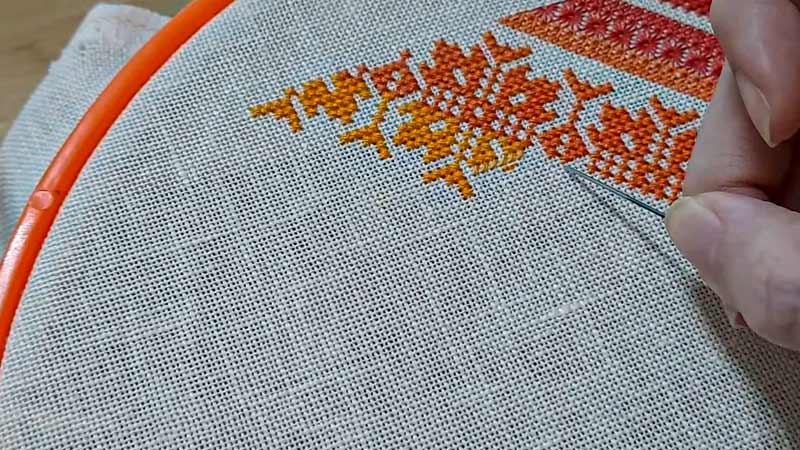
What Does a Small Symbol Mean in Cross Stitch? Cross Stitch Stitches Guide
In cross-stitch patterns, including small symbols adds a layer of intricacy to the craft, indicating fractional stitches that contribute to the overall design’s precision.
These mini symbols are crucial in representing partial needlework, allowing for more detailed and nuanced images.
Unlike whole stitches that cover a complete square on the fabric, fractional stitches involve stitching into a portion of the square, introducing a finer level of detail.
Typically denoted by smaller icons within the chart, these symbols guide the stitcher to execute stitches that are less than a whole unit, capturing the subtle nuances of the design.
Carefully integrating these fractional stitches enhances the final masterpiece, adding depth, texture, and realism to the finished cross-stitch project.
Crafters use these symbols as a roadmap, following the pattern meticulously to create a visually stunning and accurately rendered piece, showcasing the artistry and precision inherent in cross-stitching.
List of Cross Stitch Symbols and Meanings
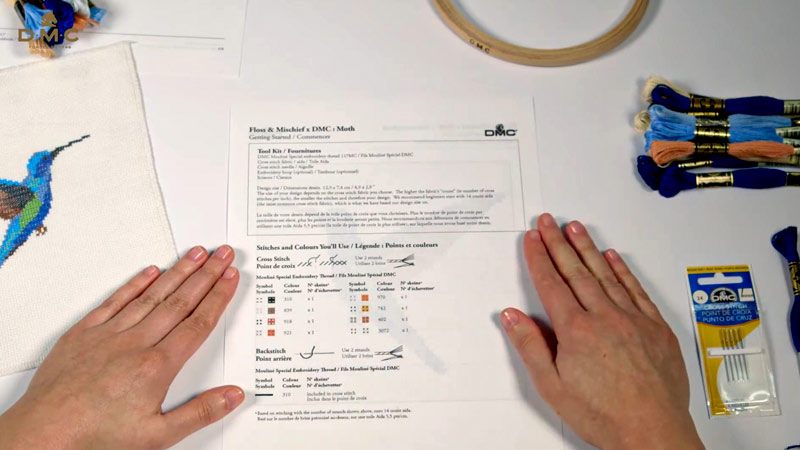
Cross stitch is a popular form of embroidery that involves creating stitched patterns on fabric using X-shaped stitches.
In cross stitch, symbols represent different colors and types of stitches on a chart or pattern. These symbols serve as a guide for the embroiderer to follow, making it easier to recreate the design on fabric.
Here is a list of common cross-stitch symbols and their meanings:
Full Cross (X)
The complete cross, represented by the “X” symbol, is the fundamental stitch in cross-stitch embroidery. It is used to fill in a single square on the fabric.
This stitch creates a solid and uniform appearance, making it ideal for covering larger areas in the design. The simplicity of the entire cross makes it easy for beginners to learn and master.
As the primary building block of cross-stitch patterns, this stitch forms the basis for creating intricate and visually appealing designs on fabric.
Half Cross (/ or )
A half cross stitch is achieved by stitching only one arm of the “X.” This stitch is commonly employed for creating finer details or outlining specific elements within a design.
The partial coverage of the fabric gives a subtle and delicate effect, making it suitable for adding intricacy to patterns.
While not as common as the whole cross, the half cross stitch is an essential technique for achieving a variety of textures and nuances in cross-stitch projects.
Backstitch (- or |)
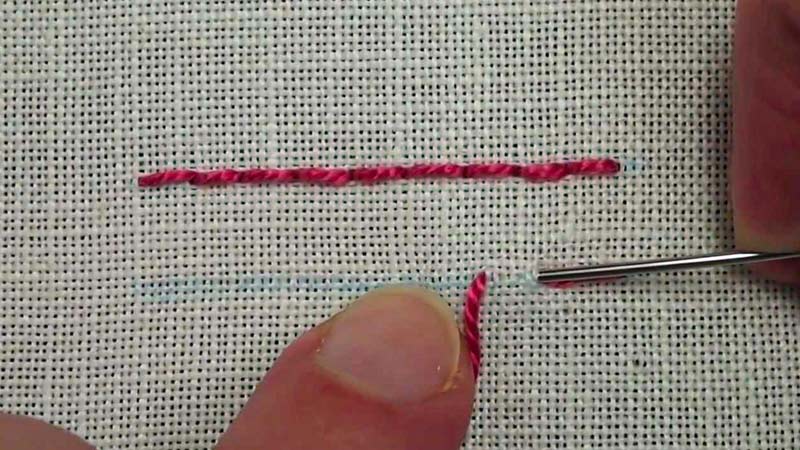
The backstitch is a crucial element in cross stitch, used for outlining and adding finer details to the overall design.
Represented by a solid or dashed line on the chart, the backstitch provides definition and sharpness to the edges of shapes and characters.
It is often used to emphasize specific features, create intricate lettering, or add a finishing touch to the completed piece.
The backstitch contributes to the precision and clarity of the design, bringing out the details in a way that the cross stitches alone may not achieve.
French Knot (o)
The French Knot is a charming embellishment in cross stitch that adds texture and dimension to the design. Represented by a small circle on the chart, this raised knot stands out from the flat surface of the fabric.
French Knots are commonly used to depict small dots and flower centers or to add a touch of elegance to specific areas of the embroidery.
While mastering the technique may take a bit of practice, the delightful texture that French Knots bring to cross stitch makes them a favorite among embroiderers seeking to enhance their projects.
Quarter Stitch (¼)
The quarter stitch is a smaller version of the entire cross, covering only a quarter of the fabric square. This stitch is often employed for creating more intricate patterns, finer details, or shading effects.
By using the quarter stitch strategically, embroiderers can achieve smoother transitions between colors and contours, adding depth and subtlety to the overall composition.
While it requires more precision, the quarter stitch is a valuable tool for expanding the creative possibilities within cross-stitch projects.
Three-Quarter Stitch (¾)
The three-quarter stitch, represented by the symbol “¾,” is a variation that covers three-quarters of a square on the fabric.
This stitch balances the whole and quarter stitches, allowing for a more nuanced approach to shading and detailing in cross-stitch patterns.
By incorporating three-quarter stitches strategically, embroiderers can achieve smoother curves and subtle variations in color intensity.
This technique is beneficial when aiming for a realistic or intricate representation in the design, offering greater flexibility in capturing fine details.
Cross Stitch with a Circle (©)
The symbol “©” is often used in cross stitch charts to represent a cross stitch made with a metallic or particular thread.
This addition introduces a unique texture or shine to the embroidery, making some design aspects stand out.
Commonly used for accents, highlights, or to replicate metallic effects, the cross stitch with a circle adds a touch of sophistication and visual interest to the overall composition.
Stitchers may experiment with specialty threads to achieve diverse and eye-catching effects in their projects.
Outline Stitch (O or °)
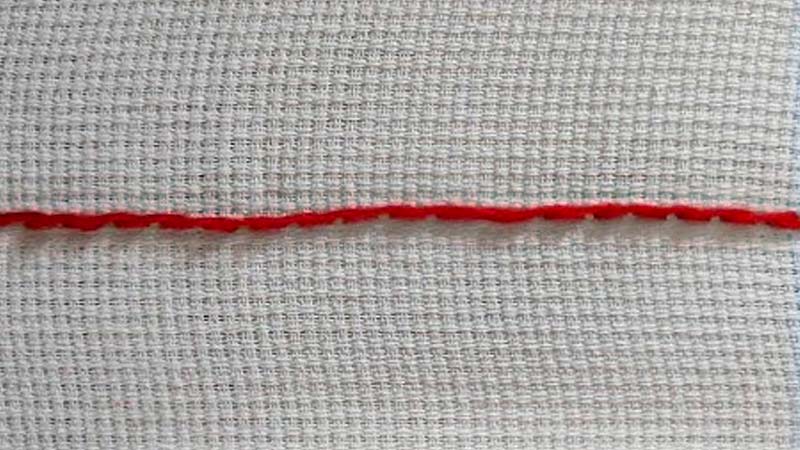
The outline stitch, represented by the symbols “O” or “°,” is a fundamental technique used to create a continuous outline around a shape in a cross-stitch pattern.
This stitch is crucial for defining the edges of the design, providing clarity and structure to the overall composition.
Whether used to delineate the contours of a character, object, or entire motif, the outline stitch enhances the readability of the pattern.
Depending on the desired effect, stitchers may choose between a solid line or a more delicate, dashed line for a softer appearance.
Dotted Line (·)
The dotted line, symbolized by “·,” is occasionally used in cross-stitch charts to represent a lighter color or a stitch not as pronounced in the design.
This subtle addition can create a sense of depth, shadow, or a faded effect in specific areas of the embroidery.
The dotted line is a versatile symbol, allowing stitchers to play with contrasts and create visual interest by varying the intensity of stitches within the same design.
Arrow (→ or ← or ↑ or ↓)
Arrows, represented by “→,” “←,” “↑,” or “↓,” are used in cross stitch charts to indicate the direction of the stitches.
This is particularly helpful when dealing with specialty stitches or patterns requiring a specific stitching sequence.
By following the arrows, stitchers can ensure that their stitches align correctly, contributing to the precision and accuracy of the final embroidered piece. Arrows are a valuable guide, especially in complex or intricate cross-stitch projects.
Color Blocks
Color blocks are crucial in cross stitch charts by representing different thread colors. Each color is assigned a distinct symbol or number in the chart, allowing stitchers to quickly identify which color to use for a specific design area.
Typically provided alongside the chart, the color key serves as a reference guide, matching symbols to the corresponding thread colors.
This systematic approach ensures accuracy in color placement, allowing embroiderers to create vibrant and visually appealing cross-stitch pieces.
Blending Filament (BF)
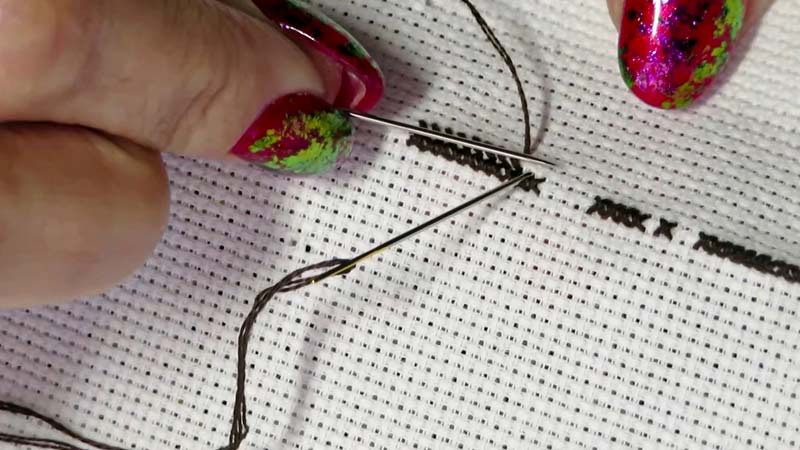
The Blending Filament (BF) symbol indicates the use of a metallic or blending filament thread in the design.
This specialty thread adds a shimmering or sparkling effect to the cross stitch, enhancing the overall visual appeal of the embroidery.
Blending filament can elevate the project and introduce a touch of glamour, whether used for small accents, highlights, or entire sections of a pattern.
Stitchers may need to adapt their technique when working with metallic threads to ensure a smooth and polished finish.
Specialty Stitches
Symbols for various specialty stitches, such as the Rhodes stitch, Smyrna cross, or Algerian eyelet, introduce texture and complexity to cross-stitch designs.
These stitches go beyond the basic full and half crosses, adding unique patterns and details to the embroidery.
Stitchers can refer to a guide or legend accompanying the chart to understand the symbols and execute these specialty stitches accurately.
Incorporating these intricate stitches allows for a more sophisticated and visually intriguing final result in cross-stitch projects.
Grid Lines
Grid lines are essential components of cross-stitch charts, serving as a visual aid to help stitchers maintain the correct placement of stitches on the fabric.
The grid divides the design into manageable sections, making it easier for stitchers to navigate complex patterns.
By following the grid lines, embroiderers can ensure the accurate alignment of stitches and maintain the overall symmetry of the design.
Grid lines contribute to the organization and precision necessary for successfully executing intricate cross-stitch patterns.
Start and End Points
Arrows or symbols indicating start and end points guide stitchers through the sequential process of creating a cross-stitch design.
These markers are handy in larger or more complex patterns where maintaining a consistent starting and ending point is crucial.
Following the specified arrows ensures that the stitches align correctly, preventing mistakes and helping stitchers achieve a polished and professional-looking finished piece. Start and end points contribute to the overall efficiency and accuracy of the cross-stitch process.
Cross Stitch Symbols Chart
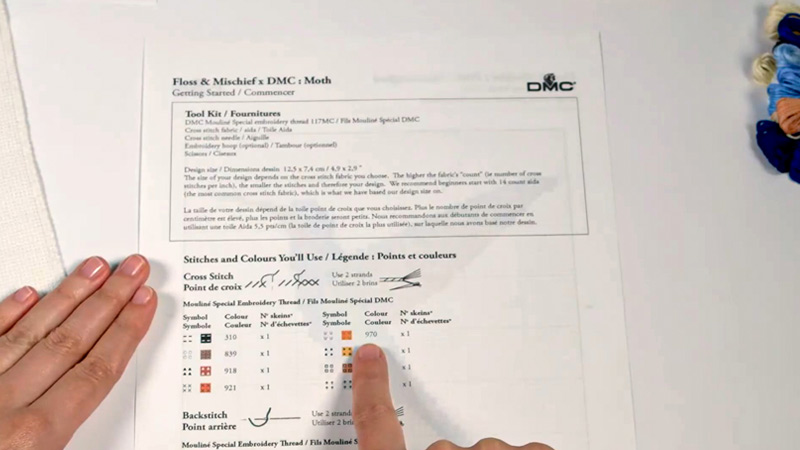
A cross stitch symbols chart is an indispensable tool for enthusiasts and embroiderers alike, serving as a visual guide to bring intricate patterns to life on fabric.
Each symbol within the chart represents a specific type of stitch, color, or technique, providing a roadmap for creating beautiful cross-stitch designs.
This systematic approach facilitates the stitching process and allows for greater creativity and precision in translating visual patterns onto fabric.
Let’s explore a sample cross-stitch symbols chart below:
| Symbol | Stitch Type | Description | Application |
| X | Full Cross | Stitching only one arm of the “X,” is often used for finer details or outlining. | The primary stitch forms the foundation of the design, suitable for covering large forms. |
| / or \ | Half Cross | It is ideal for creating delicate features, outlines, or subtlety to the overall composition. | I am outlining stitches for finer details, represented by a solid or dashed line on the chart. |
| – or | | Backstitch | It is essential for defining shapes, adding precision, and enhancing the clarity of the design. | A small circle on the chart represents a small, raised knot for adding texture. |
| o | French Knot | Introduces a tactile and dimensional element, often used for flower centers, dots, or unique accents. | Primary stitch forming the foundation of the design, suitable for covering large forms. |
| ¼ | Quarter Stitch | A smaller version of the entire cross, used for intricate patterns or shading. | Covers three-quarters of a square, ideal for smooth shading and nuanced detailing. |
| ¾ | Three-Quarter Stitch | Represents metallic or particular thread, adding sparkle to the design. | Balances coverage and detail, providing flexibility in capturing realistic representations within the design. |
| © | Cross Stitch with Circle | Ensures sharpness and structure, essential for outlining characters, objects, or motifs within the cross-stitch pattern. | Enhances specific elements with a glittering effect, commonly used for accents, highlights, or to create a focal point. |
| O or ° | Outline Stitch | Creates a continuous outline around a shape, defining the edges of the design. | Indicates the direction of stitches, which is especially useful for specialty stitches. |
| · | Dotted Line | Represents a lighter color or less pronounced stitch in the design. | Adds subtlety and variety to the embroidery, commonly used for creating shadows, highlights, or achieving a faded effect in certain areas. |
| → or ← or ↑ or ↓ | Arrow | Indicates the direction of stitches, especially useful for specialty stitches. | Guides the stitcher through the sequence of stitches, ensuring accurate execution, particularly in patterns with intricate or unique stitches. |
What Are the Purposes of Cross Stitch Symbols?
Cross-stitch symbols play a crucial role in the art of cross-stitching, serving various purposes that contribute to creating intricate and visually appealing embroidered designs.
These symbols, often presented in a chart or key accompanying cross-stitch patterns, serve the following purposes:
Color Identification
In cross-stitching, precise color identification is paramount for achieving the intended visual impact of a design.
Cross-stitch symbols are meticulously associated with specific thread colors, offering stitchers a comprehensive color key to guide their selection.
This ensures a harmonious replication of the intended color scheme, enabling embroiderers to create pieces that faithfully represent the designer’s vision.
Accurate color identification enhances the aesthetic appeal and contributes to the finished work’s overall coherence and visual balance.
Stitch Type Differentiation
The plethora of stitches in cross-stitch embroidery demands a differentiation system, and cross-stitch symbols fulfill this crucial role.
These symbols represent diverse stitch types, from the bare full cross to intricate specialty stitches.
Understanding and interpreting these symbols guide the stitcher in executing the appropriate stitches, enriching the texture, introducing shading nuances, and elevating the overall intricacy of the final piece.
Stitch-type differentiation is the key to achieving depth and dimensionality in cross-stitch projects.
Pattern Navigation
Symbols act as a visual roadmap, guiding stitchers through the intricate patterns on fabric. By following the designated sequence of symbols, stitchers can navigate the design methodically, preventing errors and maintaining the overall structure of the pattern.
This systematic approach enhances the stitching experience and ensures the accurate reproduction of the intended design.
Pattern navigation with cross-stitch symbols is akin to following a well-orchestrated map, leading the stitcher to a successful and visually pleasing outcome.
Detailing and Outlining
Certain symbols in cross-stitch charts are dedicated to detailing and outlining, enhancing shapes, characters, or motifs within the design.
Backstitches and outline stitches, for instance, add definition and sharpness, contributing to the clarity and sophistication of the embroidered piece.
These detailing symbols play a crucial role in refining the visual elements of the design, allowing stitchers to capture intricate features and create a polished, professional finish.
Specialty Stitches
Cross-stitch symbols extend beyond the basic stitches to encompass a variety of specialty stitches, each represented by a unique symbol.
From the whimsical French knots to the geometric Rhodes stitches and intricate Smyrna crosses, these symbols introduce textures, patterns, and complexities that elevate the design to new artistic heights.
Incorporating specialty stitches adds a layer of creativity, allowing stitchers to experiment and infuse their projects with unique visual interests.
Thread Substitution
The flexibility provided by symbols extends to thread substitution, allowing stitchers to adapt when a specific shade is unavailable.
By referring to the color key and understanding the symbols, embroiderers can confidently choose alternative thread colors without compromising the overall aesthetic of the design.
Thread substitution ensures adaptability and empowers stitchers to personalize their projects based on thread availability or personal preferences.
Efficient Project Execution
Cross-stitch symbols function as a visual shorthand, significantly contributing to the efficiency of the stitching process. Stitchers can quickly interpret these symbols, seamlessly transitioning between stitches and colors.
This efficiency not only expedites the completion of projects but also minimizes the likelihood of mistakes, providing a smoother and more enjoyable stitching experience.
Grid Alignment
Grid lines and symbols work in tandem to assist stitchers in maintaining the correct placement and alignment of stitches on the fabric.
This meticulous alignment ensures uniformity in the spacing and positioning of stitches, resulting in a well-balanced and visually pleasing final product.
Grid alignment is particularly crucial in intricate designs, where precision enhances the overall aesthetic appeal of the finished piece.
Thread Usage Optimization
Efficient management of thread usage is a practical aspect facilitated by cross-stitch symbols. Stitchers can plan their stitching approach to minimize thread waste by following the color key and interpreting symbols judiciously.
This thoughtful thread management contributes to cost-effectiveness and ensures uninterrupted progress during the project.
Pattern Replication
Symbols serve as a standardized communication tool, allowing for the seamless replication of cross-stitch patterns.
Stitchers can recreate the same design multiple times with consistent results by following the symbols meticulously.
This uniformity is particularly valuable for those who wish to replicate favorite patterns or create sets of coordinated pieces, maintaining a cohesive and harmonized collection of cross-stitch projects.
FAQs
What does a small symbol in a cross stitch represent?
A small symbol in a cross stitch typically represents a specific stitch or color on the embroidery chart.
Why are small symbols used in cross-stitch patterns?
Small symbols are used in cross-stitch patterns to condense information and make the chart more readable.
Can a small symbol in a cross stitch indicate a specialty stitch?
Small symbols in cross stitch charts can indicate specialty stitches, such as French knots, Smyrna crosses, or other intricate techniques.
How important is it to follow small symbols in cross stitch?
Following small symbols in cross stitches is crucial for achieving accuracy and replicating the designer’s vision.
Wrap Up
The significance of small symbols in cross stitches extends beyond mere visual cues. They are the linchpin that connects stitchers to the intricate tapestry of their creations.
These diminutive symbols, meticulously placed on embroidery charts, decode the language of stitches, colors, and specialty techniques.
As stitchers follow these symbols, they embark on a journey of creativity and precision, transforming threads into works of art.
The small symbols serve as indispensable guides, ensuring accuracy, efficient project execution, and the faithful replication of complex designs.
In the world of cross stitch, these unassuming symbols hold the key to unlocking the beauty and intricacy woven into every stitch, culminating in a finished piece that reflects the artistry of the embroiderer.
Leave a Reply